
Zinnia is a genus of plants of the tribe Heliantheae within the family Asteraceae. They are native to scrub and dry grassland in an area stretching from the Southwestern United States to South America, with a centre of diversity in Mexico. Members of the genus are notable for their solitary long-stemmed 12 petal flowers that come in a variety of bright colors. The genus name honors the German scientist Johann Gottfried Zinn (1727–1759).
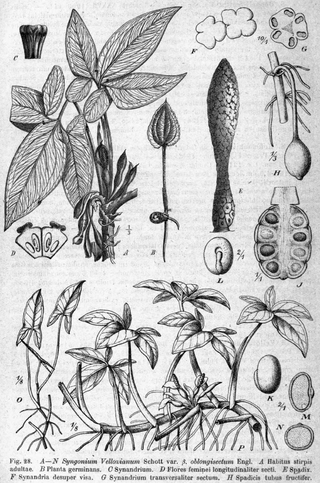
Syngonium is a genus of flowering plants in the family Araceae, native to tropical rainforests in southern Mexico, the West Indies, Central and South America. They are woody vines growing to heights of 10–20 m or more in trees. They have leaves that change shape according to the plant's stage of growth, and adult leaf forms are often much more lobed than the juvenile forms usually seen on small house plants. The scientific name of the genus comes from the Greek words σύν and γονή and refers to the fused ovaries of female flowers.
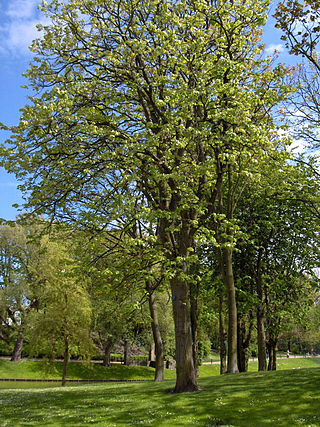
Tilia platyphyllos, the large-leaved lime or large-leaved linden, is a species of flowering plant in the family Malvaceae (Tiliaceae). It is a deciduous tree, native to much of continental Europe as well as southwestern Great Britain, growing on lime-rich soils. The common names largeleaf linden and large-leaved linden are in standard use throughout the English-speaking world except in the British Isles, where it is known as large-leaved lime. The name "lime", possibly a corruption of "line" originally from "lind", has been in use for centuries and also attaches to other species of Tilia. It is not, however, closely related to the lime fruit tree, a species of citrus.

Aralia spinosa, commonly known as devil's walking stick, is a woody species of plant in the genus Aralia of the family Araliaceae. It is native to eastern North America. The various names refer to the viciously sharp, spiny stems, petioles and even leaf midribs. It has also been known as Angelica-tree.

Parkinsonia aculeata is a species of perennial flowering tree in the pea family, Fabaceae. Common names include palo verde, Mexican palo verde, Parkinsonia, Jerusalem thorn, jelly bean tree, palo de rayo, and retama.

Hydrangea arborescens, commonly known as smooth hydrangea or sevenbark, is a species of flowering plant in the family Hydrangeaceae. It is a small- to medium-sized, multi-stemmed, deciduous shrub up to 2 m (7 ft) tall that is native to the eastern United States.

Ipomoea cairica is a vining, herbaceous, perennial plant with palmate leaves and large, showy white to lavender flowers. A species of morning glory, it has many common names, including mile-a-minute vine, Messina creeper, Cairo morning glory, coast morning glory and railroad creeper. The species name cairica translates to "from Cairo", the city where this species was first collected.

Bursera microphylla, known by the common name elephant tree in English or 'torote' in Spanish, is a tree in the genus Bursera. It grows into a distinctive sculptural form, with a thickened, water-storing or caudiciform trunk. It is found in the southwestern United States and northwestern Mexico.

Pachycormus is a monotypic genus of flowering plants in the cashew family commonly known as the Baja elephant tree, torote blanco, or copalquín. The single species Pachycormus discolor is endemic to the Baja California peninsula, with three varieties. This sarcocaulescent tree or shrub is characterized by its unique gnarled growth habit, skin-like exfoliating bark, and succulent nature, whose appearance has been colorfully described as "the proboscis of an elephant holding a nosegay," a "huge radish protruding from the ground," or "grotesque resemblances of the flexed limbs of a corpulent human being." This drought-deciduous species spends most of the year dormant, but following rains pinnate green leaves emerge, and in the late spring to summer the leaves yellow, fall, and give way to bright red, cream, or pink flowers that give it a striking appearance in bloom.

Hydrangea radiata is an attractive, deciduous shrub up to 3 m tall in the flowering plant family Hydrangeaceae. Its natural range is limited to the southern Appalachians, where it is fairly common. Its common names—silverleaf hydrangea or snowy hydrangea—reflect its distinctive foliage which is dark green on top and silvery white below; the sharply contrasting foliar colors makes this shrub conspicuous at a distance, especially in a breeze.

Celtis reticulata, with common names including netleaf hackberry, western hackberry, Douglas hackberry, netleaf sugar hackberry, palo blanco, and acibuche, is a small- to medium-sized deciduous tree native to western North America.

Arytera divaricata, known as the gap axe, coogara, coogera or rose tamarind is a forest tree of eastern Australia. An attractive plant with glossy pale and limp new leaves. It grows in fairly dry situations, often in littoral rainforests and monsoon forest.
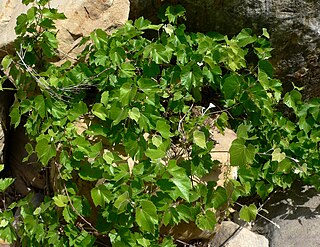
Vitis arizonica is a North American species of wild grape. It is a deciduous vine.

Arytera distylis, known as the two-leaved coogera or twin-leaved coogera is a rainforest tree of eastern Australia. It grows by streams or in seaside rainforests. It occurs from the Orara River in the Mid North Coast region of New South Wales, extending up to Maryborough in southeast Queensland.
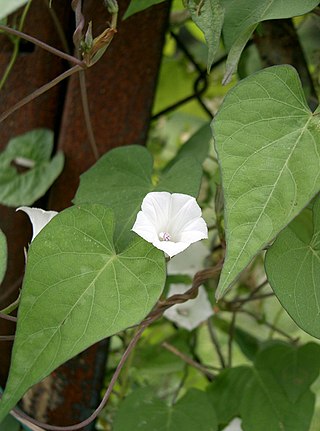
Ipomoea lacunosa, the whitestar, white morning-glory or pitted morning-glory, is a species that belongs to the genus Ipomoea. In this genus most members are commonly referred to as "morning glories". The name for the genus, Ipomoea, has roots in the Greek words ips and homoios, which translates to worm-like. This is a reference to the plant's vine-like growth. Lacunosa comes from a Latin word meaning air spaces, correlating with the venation of the leaves. Ipomoea lacunosa is native to the United States and grows annually. The flowers of this species are usually white and smaller than most other morning glories.

Mariosousa heterophylla, also called the palo blanco tree, palo liso, guinola, and Willard acacia, is a normally evergreen mimosoid plant in the genus Mariosousa native to Mexico. The Spanish common name translates into 'white stick', defining its peeling white bark. A compound called willardiine, that acts as an agonist in glutamate receptors, can be isolated from M. heterophylla.

Ambrosia salsola, commonly called cheesebush, winged ragweed, burrobush, white burrobrush, and desert pearl, is a species of perennial shrub in the family Asteraceae native to deserts of the southwestern United States and northwestern Mexico.
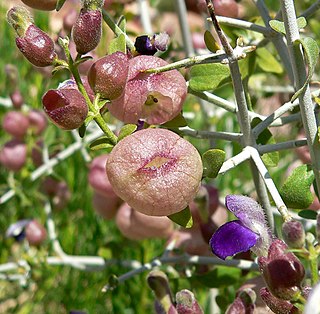
Scutellaria mexicana, commonly known by variants on bladder sage or paperbag bush, is a shrub of the mint family Lamiaceae distinctive for its calyx lobes that develop into small bag- or bladder-like shells around the fruits.
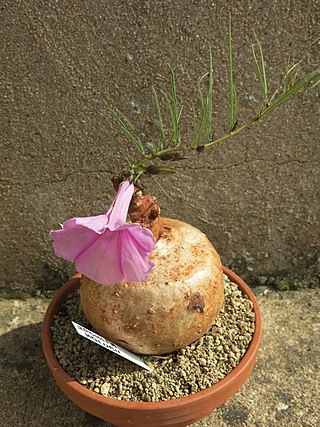
Ipomoea holubii is a species of flowering plant in the family Convolvulaceae.

Lysiloma candidum, most commonly known as the palo blanco, is a tree of the family Fabaceae near-endemic to the Baja California Peninsula in Mexico. It may grow to a height of 10 metres (33 ft) and is one of the few spineless woody legumes in the region. It has compound leaves with oval gray-green leaflets. The creamy-white, globose clusters of flowers bloom in March through May and perfume the air with a light, spicy fragrance. The flowers are followed by red-brown pods up to 15 centimetres (5.9 in) long that hang delicately on the thin branches. This species is distributed throughout the Baja California Peninsula, from Rancho El Barril in southern Baja California state to the Cape region of Baja California Sur, and is also very rarely found in the state of Sonora.























